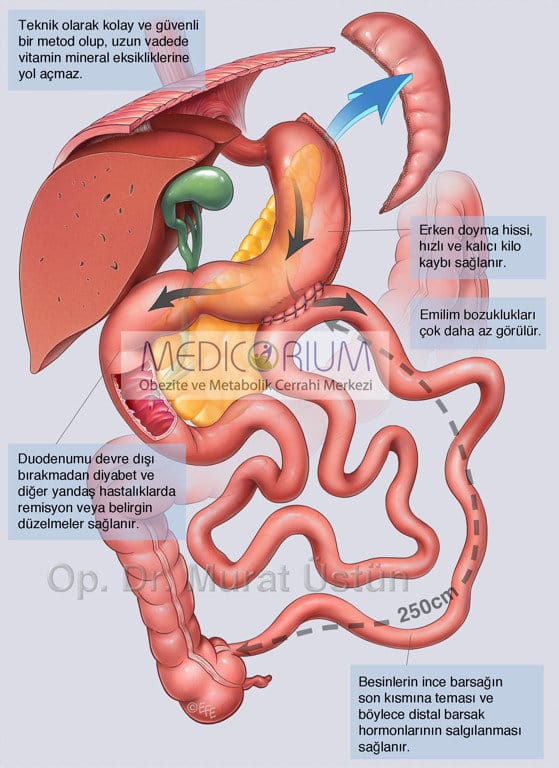Sleeve gastrectomy + Transit bipartition surgery is a relatively new technique announced for the first time in Sergio Santoro’s article in 2012. The rationale behind this surgical procedure is that the obesity and diabetes booms associated with modern diets can be avoided by reversing the process, in which no undigested foods remain until foods reach advanced points of the small intestine as a result of industrialization.
Many studies conducted in the 90’s revealed the clues of the fact that the increased absorption in the uppermost parts of the digestive system leads to enterohormonal diseases and diabetes in particular. In 1997, an old bariatric surgery procedure called jejunoileal bypass has been proven to act by having a long-lasting effect on GLP-1 secretion. In 1998, the world was shaken by an article suggesting that diabetes is actually a disease of the foregut, i.e. the uppermost part of the digestive system. Therefore, absorption-reducing procedures have begun to be a field of interest.
Sleeve gastrectomy + Transit bipartition surgery is a relatively new technique announced for the first time in Sergio Santoro’s article in 2012. The rationale behind this surgical procedure is that the obesity and diabetes booms associated with modern diets can be avoided by reversing the process, in which no undigested foods remain until foods reach advanced points of the small intestine as a result of industrialization.
Many studies conducted in the 90’s revealed the clues of the fact that the increased absorption in the uppermost parts of the digestive system leads to enterohormonal diseases and diabetes in particular. In 1997, an old bariatric surgery procedure called jejunoileal bypass has been proven to act by having a long-lasting effect on GLP-1 secretion. In 1998, the world was shaken by an article suggesting that diabetes is actually a disease of the foregut, i.e. the uppermost part of the digestive system. Therefore, absorption-reducing procedures have begun to be a field of interest.
New approaches intended for correcting this signaling error in the intestinal system have begun to be developed in the light of these developments in the history of bariatric and metabolic surgeries. In Santoro’s article, it has been stated that high-glycemic index foods cause hormonal hyperactivity in the uppermost part of the digestive system, while developing hypoactivity in the lowermost parts. Transit bipartition has been developed to correct this imbalance.
Santoro examined 1,020 obese patients. Those patients were observed to lose 94% of their excess weights, feel early satiety, and experience 86% improvement in their diabetes. The mortality rate is 2 per thousand. No severe malabsorption has been observed. In brief, transit bipartitisation is a very effective surgical procedure that can lead to a rapid, effective and permanent weight loss and significant improvement in comorbidities.
On the other hand, Loop Transit Bipartition is a relatively lower-risk version developed from all methods available up to now, which is as effective as any other surgical procedures in the treatment of Type 2 diabetes. It is a technically easy-to-perform and safe procedure, and its greatest advantage is that it does not cause deep vitamin mineral deficiencies. With the effect of sleeve gastrectomy, the sense of early satiety and reduced appetite are observed. A considerable improvement can be achieved in diabetes and other comorbidities, without by-passing the duodenum.

How is Loop Transit Bipartition Performed?
The first stage of the procedure is a slightly larger sleeve gastrectomy. By this means, the effect of the Ghrelin effect i.e. the reduced appetite, and the attenuation of the antiinsulin mechanism are utilized. Afterwards, a passage is formed in such a way as to ensure it to extent from a little bit behind the gastric outlet to the point located 250 cm behind the junction of the small and large intestines.
In scintigraphic studies, it has been showed that 2/3 of the gastric content passes through the newly formed passage, while the rest of it passes through the pylorus. The advantages achieved in this way are as follows:
- Since it also have absorption-reducing effect, it promises a greater weight loss effect than sleeve gastrectomy.
- Leakage is the most frightening complication of sleeve gastrectomy. The most important cause of the leakage is high pressure. This anastomosis reduces the risk of leakage by reducing the gastric pressure and.
- The hormonal thermostat mechanism is corrected because it both restricts caloric intake and accelerates the gastric-emptying process.
- Since no part of the digestive system is by-passed, the concerns arising from gastric bypass are eliminated. All regions of the digestive system are endoscopically accessible.
- Since a certain portion of foods passes through the normal way, it causes less vitamin mineral deficiencies compared to SADI-S, one of the potent surgical procedures.
- The intestinal distance can be adjusted based on the severity of the diabetes. The surgery can be easily reversed.
- It is a revision procedure that can be performed much more practically than any other revision procedures, especially after sleeve gastrectomy, following which weight regain is observed.
We are the pioneer in also loop transit bipartition besides many other bariatric surgery procedures. All the success levels targeted for patients have been achieved up until now. No leakage or major complication has developed.
